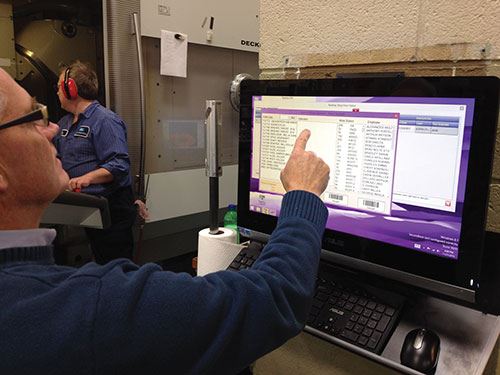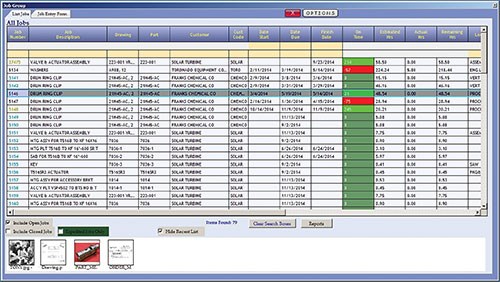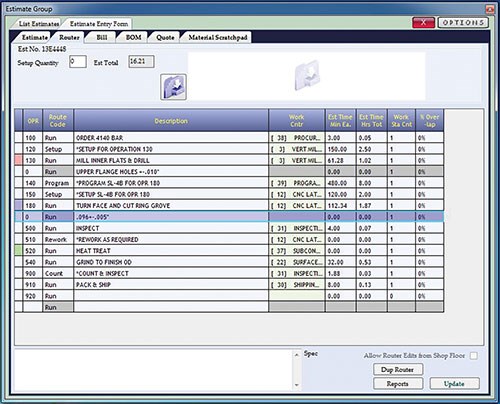ERP Software Improves Aerospace Shop’s Operational Efficiency
Talsco Manufacturing Inc. improved its operational efficiency by implementing new ERP modules from Realtrac.
Share




In many cases, enterprise resource planning (ERP) software can help shops improve productivity. But software alone can’t help shops fully achieve their goals if its capabilities aren’t being maximized. This was a problem for Talsco Manufacturing Inc. of Garden Grove, California. The company was already using ERP software on a small scale to help manage its operations, but during a period of strong growth, it just wasn’t enough. By adding additional software modules, the shop was able to achieve better on-time delivery, improve quality and inventory control and save money.
The family-owned, medium-sized company was founded in 1968 and now provides highly customized sheet metal components to an elite list of aerospace companies and the U.S. military. In recent years, the company’s growth can be attributed, in part, to its strong leadership and highly skilled workforce. One of these employees is Jeff Piaskowski. When he joined the company more than five years ago, he was tasked with improving operational efficiency and given vital management support to do so.
Stepping into an established family operation and being charged with making big changes is not an easy task, but Mr. Piaskowski began by learning to use the company’s ERP software. Talsco had been using one module from Realtrac (Livonia, Michigan) for order entry only. However, as Mr. Piaskowski soon discovered, the software had many more capabilities that remained untapped.
Over the next few months, Mr. Piaskowski worked to build the case for each new module he added, eventually adding many more over the next three years. Each time, he did his homework, learned what each module could do specifically for Talsco and took his plan to management. He then worked with his team on implementation. The results quickly showed that the new software modules were rapidly improving the company’s operational efficiency, saving both time and money.
For example, Talsco now uses the flexibility of the job scheduling feature of the ERP software in two different ways. The first way is to input a project and a start date to know what date the order will be complete. This feature has benefited the aerospace shop by enabling it to provide better than 99 percent on-time delivery. The second way the company uses the feature is to leverage its backwards scheduling. By inputting the delivery date, the system provides the day the job needs to start in order to be ready on time.
“If we start it late or early, the software will tell us how many days we are behind or ahead of schedule. Realtrac also uses this information to tell us what our highest-priority jobs are so that we have full visibility and knowledge of what is ‘hot,’” Mr. Piaskowski says. “Everyone can see what jobs are top priorities at all times, ensuring the entire team is focused on the right projects.”
Talsco also added Realtrac’s “Tree Module” to schedule assembly and multi-level jobs. This is critical for parts that are made of multiple components, because it provides a view into the critical path for the entire project. Realtrac enables the company to schedule all the components in the order they have to be manufactured to produce a complete assembly by a certain date, making complex jobs much easier for the company to manage, Mr. Piaskowski says.
For Talsco and other aerospace manufacturers, audits are critically important. Mr. Piaskowski says it used to take as many as four weeks to prepare for an audit, but now it can be done in a couple of days. He attributes the company’s recent audit success to the Realtrac software, which tracks every aspect of an audit.
“Not only has the company saved time, but our last audit for AS9100 was perfect. Not one thing was written up by the auditor, which is huge. In fact, it’s nearly unheard of,” Mr. Piaskowski says.
The ERP system has also improved paperwork efficiency. Although necessary, paperwork can be a time waste that can delay the start of important jobs. At Talsco, this is not the case. For example, when the company quotes a new project and sets it up, everything Mr. Piaskowski’s team needs is at their fingertips. They do not leave their desks to track down information or materials, he says. Once the job is set up, it can be started immediately.
In the same vein, the ERP system helps Talsco better track its materials and improve quality control. Employees do not have to go to a storage area to find which materials are in stock. Instead, the Talsco team can view its entire inventory in Realtrac from anywhere. For example, the company can automatically track every piece of raw material, from sheet metal to specific finished parts, right in the Realtrac software. Knowing exactly which sheet of aluminum was used to make a specific finished part is a critical element of the quality control process in aerospace applications. Today, that capability is built into Talsco’s process, and it takes no additional time or paperwork.
Resource utilization has enabled Talsco to optimize its production schedule and capacity, especially as the company continues to grow quickly.
“We were already pretty efficient, but the software has helped us know when we need to purchase new equipment. It tells us when we simply don’t have the capacity for a new job,” Mr. Piaskowski says. He now knows when it might be necessary to order a new machine to minimize expensive outsourcing.
Adding new modules to the ERP software helped Talsco quickly realize a return on its investment. “It would be absolutely impossible to manage the kind of growth and the quality improvements we have seen without Realtrac,” Mr. Piaskowski says.
Related Content
Cutting Part Programming Times Through AI
CAM Assist cuts repetition from part programming — early users say it cuts tribal knowledge and could be a useful tool for training new programmers.
Read MoreGenerating a Digital Twin in the CNC
New control technology captures critical data about a machining process and uses it to create a 3D graphical representation of the finished workpiece. This new type of digital twin helps relate machining results to machine performance, leading to better decisions on the shop floor.
Read More6 Machine Shop Essentials to Stay Competitive
If you want to streamline production and be competitive in the industry, you will need far more than a standard three-axis CNC mill or two-axis CNC lathe and a few measuring tools.
Read More4 Commonly Misapplied CNC Features
Misapplication of these important CNC features will result in wasted time, wasted or duplicated effort and/or wasted material.
Read MoreRead Next
Registration Now Open for the Precision Machining Technology Show (PMTS) 2025
The precision machining industry’s premier event returns to Cleveland, OH, April 1-3.
Read More5 Rules of Thumb for Buying CNC Machine Tools
Use these tips to carefully plan your machine tool purchases and to avoid regretting your decision later.
Read MoreSetting Up the Building Blocks for a Digital Factory
Woodward Inc. spent over a year developing an API to connect machines to its digital factory. Caron Engineering’s MiConnect has cut most of this process while also granting the shop greater access to machine information.
Read More





























.jpg;maxWidth=300;quality=90)








